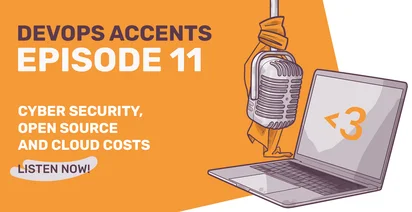Cyber Security, Open Source and Cloud Costs |🎙️#11

In this episode of DevOps Accents, Leo, Pablo and Kirill talk about security and everything around it.
- Compatibility of open source and cyber security — can openess and security co-exist?
- What do you do when you find a vulnerability in software?
- How easy is it to be a hacker nowadays?
- The dangers of security of things: hack a car, hack a plane;
- Who tracks security issues in a company?
- How do you know if you're watched or tracked?
- + cloud costs automation.
You can listen to episode 11 of DevOps Accents on Spotify, or right now:
The rapid adoption of open-source technologies and the cloud has ushered in a new era of innovation, democratizing the tools necessary for software development and distribution. However, this transformation brings forth a critical debate on the compatibility of open-source technologies with cybersecurity. The essence of open-source software—its openness and community-driven nature—poses unique challenges and opportunities in ensuring the security of digital infrastructures.
Open Source vs. Proprietary Software: A Security Perspective
One of the most significant advantages of open-source software is its transparency. The notion that "given enough eyeballs, all bugs are shallow," often referred to as Linus's Law, suggests that the open review process inherent to open-source projects can lead to more secure software. This transparency allows for constant scrutiny by a global community of developers, potentially leading to the identification and resolution of vulnerabilities at a quicker pace than in closed-source environments.
However, this openness also raises concerns. The visibility into the software's inner workings could potentially offer malicious actors insights into vulnerabilities, enabling them to exploit these weaknesses before they're patched. Despite this, the collaborative nature of open-source projects often means that security patches are developed and distributed swiftly, provided the community is active and engaged.
The Role of Cloud Infrastructure in Security
The conversation around open-source software and security is further complicated by the integration of cloud technologies. Cloud platforms offer immense scalability and flexibility but also introduce a layer of complexity in managing security. The shared responsibility model in cloud computing dictates that while cloud providers secure the infrastructure, clients are responsible for securing their data and applications. This model requires a deep understanding of cloud services and the security tools they offer, which can be a daunting task for teams not specialized in cybersecurity.
Tools and Strategies for Managing Open-Source Security
To navigate the complexities of open-source and cloud security, organizations utilize various tools and strategies. Security scanners and dependency checkers are essential for identifying known vulnerabilities in open-source libraries. Moreover, infrastructure as code (IaC) tools, such as Terraform, enable teams to define and manage their cloud resources programmatically, allowing for the implementation of security best practices at the infrastructure level.
Cost optimization tools also play a crucial role in managing cloud resources efficiently, preventing over-provisioning and reducing the attack surface. These tools, coupled with continuous monitoring and threat detection systems, provide a multi-layered defense strategy against potential security threats.
Cloud infrastructure costs can quickly spiral out of control, leaving you with unexpected expenses. That’s why we’re offering a Free Cloud Cost Audit — to help companies uncover hidden inefficiencies and optimize their cloud spending. Our goal is simple: empower you with actionable insights so you can take control of your cloud budget.
Learn more about the audit and how we can help here, or fill in the application for right away:
The Human Element in Cybersecurity
Ultimately, the effectiveness of security measures in open-source and cloud environments heavily relies on the human element. Education and awareness among developers, system administrators, and users are crucial. Organizations must foster a culture of security, where best practices are followed, and security considerations are integrated into every stage of the development and deployment process.
Conclusion
The debate on open-source software and cybersecurity is far from settled. While open-source projects offer the potential for more secure and robust software through community collaboration, they also require vigilance in monitoring, patching, and securing the software and the environments in which it operates. As the cloud continues to shape the future of technology, understanding the nuances of open-source security will be paramount for organizations looking to leverage these tools effectively. Balancing innovation with security in this rapidly evolving landscape will continue to challenge and inspire the tech community.
Podcast editing: Mila Jones, milajonesproduction@gmail.com
